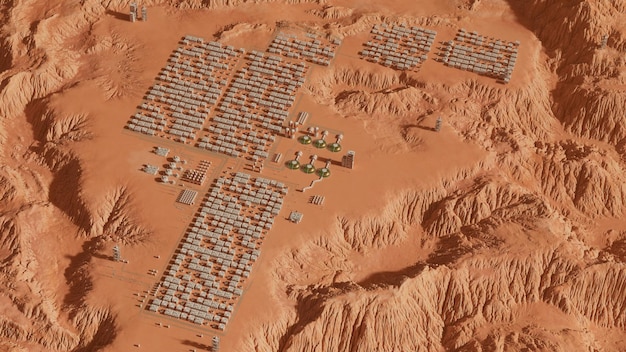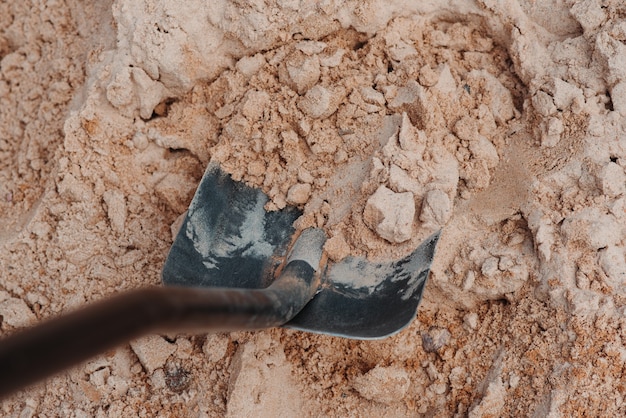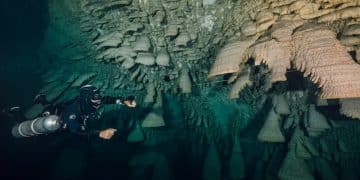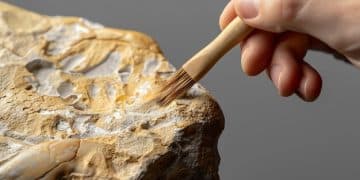The Future of Archaeology: Drones & AI Uncover Ancient US Sites

The future of archaeology in the US is being revolutionized by drones and AI, offering unprecedented capabilities for discovering and analyzing ancient sites. These technologies enable faster, more comprehensive surveys, and deeper insights into past civilizations, transforming how archaeologists approach their work.
The field of archaeology is rapidly evolving, and in the United States, this transformation is largely being driven by the integration of cutting-edge technologies. The future of archaeology: How drones and AI are transforming the search for ancient sites in the US is no longer a futuristic concept but a tangible reality, reshaping how we explore, document, and understand our past.
From the skies above to the algorithms crunching data, these innovations are providing archaeologists with tools to uncover secrets hidden for centuries, promising a new era of discovery and understanding.
Unveiling the Past: The Role of Drones in Archaeological Surveys
Archaeological surveys are often time-consuming and labor-intensive, requiring extensive fieldwork and meticulous documentation. However, drones are changing this landscape, offering a bird’s-eye view that can dramatically speed up the process and uncover previously unnoticed features.
Enhanced Site Mapping with Drone Technology
Drones equipped with high-resolution cameras and LiDAR (Light Detection and Ranging) technology can create detailed 3D maps of archaeological sites. This allows researchers to visualize the landscape in unprecedented detail, identifying subtle variations in topography that may indicate the presence of buried structures or features.
Vegetation Mapping Using Drones
Drones can also play a very vital role in understanding the vegetation of a given place. They can identify areas with plantlife that might indicate the past locations or areas.
Drones equipped with multispectral sensors can analyze vegetation health, identifying areas where plant growth is stunted or altered due to underlying archaeological features. Here are some of the benefits:
- Unmanned Systems: Drones can reach locations that are dangerous for humans
- Data Collection: Drones can collect data rapidly and repeatedly, in real time
- Cost effective: Drones are more time-saving and less prone to error.
This information can help archaeologists pinpoint promising areas for further investigation, saving time and resources.
With the help of advanced sensors in the drones, researchers can save a lot of time and money while having access to valuable data. This data can also be made public for others to use.

The use of drones in archaeological surveys is transforming the way archaeologists approach their work, enabling them to identify and map sites more efficiently and effectively. It is also contributing to the future of archaeology: How drones and AI are transforming the search for ancient sites in the US.
AI-Powered Analysis: Decoding Archaeological Data
The vast amounts of data collected during archaeological surveys can be overwhelming. Artificial intelligence (AI) is emerging as a powerful tool for analyzing this data, helping archaeologists to identify patterns, anomalies, and relationships that would be difficult or impossible to detect manually.
Machine Learning for Artifact Identification
Machine learning algorithms can be trained to recognize and classify artifacts based on their shape, size, color, and other characteristics. This can significantly speed up the process of artifact identification, allowing archaeologists to focus on more complex research questions.
Predictive Modeling in Archaeology
AI can also be used to build predictive models that identify areas with a high probability of containing archaeological sites. These models can incorporate a variety of factors, such as topography, geology, hydrology, and historical land use, to generate maps that guide archaeological surveys.
These are some benefits of Predictive Modeling
- Increases the probability of finding the artifacts
- Can be used in museums to model past events
- It can also be used to predict the preservation of given artifacts
AI algorithms are revolutionizing the way archaeological data is analyzed, providing new insights into past civilizations and helping to prioritize areas for further investigation. As we look at the future of archaeology: How drones and AI are transforming the search for ancient sites in the US, it is safe to say that AI has contributed greatly.

Case Studies: Drone and AI Success Stories in US Archaeology
Several successful projects in the US have already demonstrated the potential of drones and AI in archaeology. These case studies provide valuable insights into how these technologies can be applied in different contexts and what types of discoveries they can facilitate.
Chaco Canyon: Uncovering Ancient Roads with LiDAR
In Chaco Canyon, New Mexico, drones equipped with LiDAR technology have been used to map the extensive network of ancient roads that connected the major ceremonial centers of the Ancestral Puebloan culture. This has revealed new details about the scale and complexity of this ancient civilization.
Mesa Verde: Monitoring Cliff Dwellings with Drones
In Mesa Verde National Park, Colorado, drones are being used to monitor the condition of the famous cliff dwellings, providing valuable data on erosion, structural stability, and visitor impacts. This information is helping park managers to develop effective strategies for preserving these fragile sites.
Advantages
- They are non invasive and avoid damage to the sites.
- Drones can be used to monitor a wide range of artifacts.
- They give a very detailed analysis of the given area.
These examples highlight the diverse applications of drones and AI in US archaeology, showcasing their ability to enhance site discovery, documentation, and preservation efforts. As we look at the future of archaeology: How drones and AI are transforming the search for ancient sites in the US, it is not hard to see the contributions of using drones and AI.
Ethical Considerations and Challenges
While drones and AI hold great promise for archaeology, it is important to consider the ethical implications and challenges associated with their use. These technologies raise important questions about data privacy, site security, and the potential for misuse.
Data Privacy and Indigenous Knowledge
Archaeological sites often contain sensitive information about past cultures, including burial sites, religious artifacts, and traditional ecological knowledge. It is crucial to ensure that data collected by drones and AI is handled responsibly and that indigenous communities are consulted about its use.
Site Security and Looting
The detailed maps and data generated by drones can potentially be used by looters to target vulnerable archaeological sites. Measures must be taken to protect this information and prevent it from falling into the wrong hands.
The Digital Divide.
- Equity must be ensured so that everybody can profit.
- Some communities can not afford the tools required to run the AI.
- AI biases can result in the disregard of other regions when conducting research
Addressing these ethical considerations and challenges is essential to ensure that the use of drones and AI in archaeology is both responsible and beneficial. There must be clear guidelines and ethical boundaries when doing research for the future of archaeology: How drones and AI are transforming the search for ancient sites in the US
Training the Next Generation of Archaeological Scientists
The increasing integration of drones and AI in archaeology requires a new generation of archaeologists who are trained in these technologies. Educational programs and training initiatives are needed to equip students and professionals with the skills and knowledge they need to effectively use these tools.
Integrating Technology into Archaeology Curricula
Universities and colleges should incorporate drone operation, data analysis, and AI programming into their archaeology curricula. This will ensure that graduates are prepared for the changing demands of the profession.
Hands-on Training and Workshops
Hands-on training and workshops can provide archaeologists with practical experience in using drones and AI for archaeological research. These programs should cover topics such as flight planning, data processing, and algorithm development.
Online Training
- It helps bring this research at a wide level
- Online training is accessible to all
- These resources can be stored for later review
By investing in education and training, we can ensure that the next generation of archaeologists is well-equipped to harness the power of drones and AI for the benefit of archaeological research and heritage preservation. These new scientists will be able to shape the future of archaeology: How drones and AI are transforming the search for ancient sites in the US.
The Future Landscape of US Archaeology
The integration of drones and AI is poised to revolutionize archaeology in the US, opening up new possibilities for discovery, analysis, and preservation. As these technologies continue to develop, we can expect even more transformative changes in the years to come. The future of archaeology: How drones and AI are transforming the search for ancient sites in the US is becoming more clear.
Augmented Reality and Virtual Reality
AR and VR technologies can be used to create immersive experiences that allow the public to explore and interact with archaeological sites. This can enhance engagement and promote a deeper understanding of our shared cultural heritage.
Automated Excavation and Analysis
In the future, we may see the development of robots and AI-powered systems that can automate the process of excavation and analysis, reducing the need for manual labor and improving the accuracy of data collection.
AI in Excavation
- Safety can be improved by avoiding possible accidents
- Accuracy in collecting samples on excavation
- AI can also be used to do some repetitive tasks
The possibilities are endless, and as we continue to push the boundaries of technology, we can expect even more exciting and transformative changes in the field of archaeology. As we look towards the future of archaeology: How drones and AI are transforming the search for ancient sites in the US, it is important to remember that technology is just one tool in the archaeologist’s toolkit.
| Key Point | Brief Description |
|---|---|
| 📸 Drone Surveys | Drones quickly map sites, aiding in the discovery of new archaeological features. |
| 🤖 AI Analysis | AI algorithms analyze data, identifying artifacts and predicting site locations efficiently. |
| 📚 Training | New programs are training archaeologists to use drones and AI effectively. |
Frequently Asked Questions
Drones equipped with cameras and sensors map sites quickly and safely, identifying subtle features that indicate potential archaeological finds. They provide a bird’s-eye view for more comprehensive surveys. This has contributed to the future of archaeology and how drones and AI are transforming the search for ancient sites in the US.
AI algorithms analyze large datasets, identify artifacts, and predict the location of undiscovered sites. Machine learning speeds up artifact analysis and reveals new insights into past civilizations.
Yes, concerns include data privacy, protecting indigenous knowledge, and preventing looting. Responsible data handling and community consultation are essential for the future of archaeology: How drones and AI are transforming the search for ancient sites in the US.
Educational programs are integrating drone operation, data analysis, and AI programming into archaeology curricula to train the next generation of archaeologists in these tools.
Future trends include augmented reality experiences, automated excavation systems, and AI-powered robots that will streamline data collection and analysis, revolutionizing how we uncover the past. This is further enhancing the future of archaeology and how drones and AI are transforming the search for ancient sites in the US.
Conclusion
The integration of drones and AI into archaeological research is reshaping our understanding of the past and in the US this is definitely becoming the most common method. The future of archaeology: How drones and AI are transforming the search for ancient sites in the US is no longer a distant vision but a tangible reality.
By embracing these technologies responsibly and ethically, we can unlock new insights into human history and preserve our cultural heritage for generations to come.





